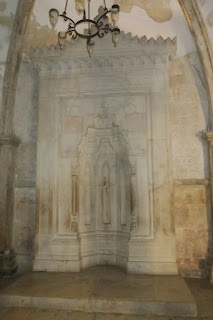Cenacle (from Latin cēnāculum "dining room", later spelt
coenaculum), also known as the "Upper Room" (from Koine Greek
anagaion and hyperōion, both meaning "upper room") was the first
Christian church. It is a room in the David's Tomb Compound in Jerusalem , and
was traditionally held to be the site of the Last Supper.
The language in Acts suggests that the apostles used the room as a temporary
residence, although the Jamieson-Fausset-Brown Bible Commentary disagrees,
preferring to see the room as a place where they were "not lodged, but had for
their place of rendezvous."
In Christian tradition, the room was not only the site of the Last Supper
(i.e. the Cenacle), but the room in which the Holy Spirit alighted upon the
eleven apostles after Pentecost. It is sometimes thought to be the place where
the apostles stayed in Jerusalem.
|
Gate of the Cenacle (left) and Gate of King David's Tomb (right).
|
|
The Upper Room.
The Cenacle (from the Latin cenaculum, "dining room"), also known
as the Upper Room (from the Koine Greek anagaion and
hyperōion, both meaning "upper room"), is located on the first
floor of the building.
|
|
Gate of the Cenacle (Room of the Last Supper).
The building has experienced numerous cycles of destruction and
reconstruction, culminating in the Gothic structure which stands today.
|
|
The Cenacle.
In its current state, the Cenacle is divided into six rib-vaulted bays.
-
The bays are supported by three freestanding columns which bilaterally
divide the space, as well as six pillars flanking the side walls.
-
While the capital of the westernmost freestanding column is flush with
the Cenacle's interior wall, the column shaft itself is completely
independent of the wall, leading scholars to consider the possibility
that this wall was not original to the building.
|
|
Pentecost.
According to the New Testament, the Cenacle was a place in which the
apostles continued to gather after the Last Supper, and it was also the
site where the Holy Spirit alighted upon the eleven apostles on
Pentecost.
-
Pentecost is a Christian holiday which takes place on the 50th day
(the seventh Sunday) after Easter Sunday. It commemorates the descent
of the Holy Spirit upon the Virgin Mary and the Apostles of Jesus
Christ.
-
The events of Acts Chapter 2 are set against the backdrop of the
celebration of Pentecost in Jerusalem. There are several major
features to the Pentecost narrative presented in the second chapter of
the Acts of the Apostles.
-
The author begins by noting that the disciples of Jesus "were all
together in one place" on the "day of Pentecost".
-
There is a "mighty rushing wind" (wind is a common symbol for the Holy
Spirit) and "tongues as of fire" appear.
-
The gathered disciples were "filled with the Holy Spirit, and began to
speak in other tongues as the Spirit gave them utterance".
-
See more at
Pentecost - Wikipedia.
|
|
The mihrab.
In 1524, during Suleiman the Magnificent's rule, Ottoman authorities
took possession of the Cenacle, converting it into a mosque: the Mosque
of the Prophet David.
-
The Franciscans were evicted from their surrounding buildings in 1550.
-
Architectural evidence remains of the period of Muslim control
including the elaborate mihrab in the Last Supper room, the Arabic
inscriptions on its walls, the qubba over the stairwell, and the
minaret and dome atop the roof.
|
|
Bronze olive tree.
Bronze replica of an olive tree gifted by Pope John Paul II to symbolize
peace between Judaism, Christianity and Islam.
|
|
Small canopic dome over the stairs.
|
|
Wall with Ottoman datestone.
1524 AD (930 AH) Ottoman datestone commemorating the conversion into a
mosque.
|
|
Capital with pelicans.
Capital decorated with pelicans, a symbol of Jesus in Christian
iconography
|
|
Going up towards the terrace.
|
|
The two windows of the Cenacle.
The two stained glass windows, with an inscription: 'judge between the
people in truth and do not follow [your own] desire', from Quran 38:26,
known as the "Story of David and the Two Litigants".
|
|
Gathering of believers singing hymns.
|
See also
Source
Location

























